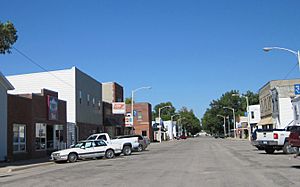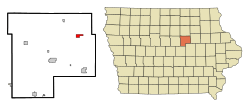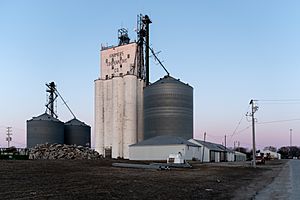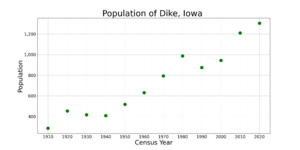Dike, Iowa facts for kids
Quick facts for kids
Dike, Iowa
|
|
|---|---|
 |
|
| Motto(s):
"A Slice of Iowa"
|
|

Location of Dike, Iowa
|
|
| Country | |
| State | |
| County | Grundy |
| Area | |
| • Total | 1.39 sq mi (3.60 km2) |
| • Land | 1.39 sq mi (3.60 km2) |
| • Water | 0.00 sq mi (0.00 km2) |
| Elevation | 942 ft (288 m) |
| Population
(2020)
|
|
| • Total | 1,304 |
| • Density | 938.80/sq mi (362.39/km2) |
| Time zone | UTC-6 (Central (CST)) |
| • Summer (DST) | UTC-5 (CDT) |
| ZIP code |
50624
|
| Area code(s) | 319 |
| FIPS code | 19-21405 |
| GNIS feature ID | 0455920 |
| Website | The City of Dike, Iowa Website |
Dike is a small city located in Grundy County, Iowa, in the United States. It's a friendly place that was home to 1,304 people in 2020. This was a big jump from the 944 residents counted in 2000! Dike is also part of the larger Waterloo–Cedar Falls area.
Contents
History of Dike
The city of Dike gets its name from Chester Thomas Dike. He was an engineer who helped build railroads. Mr. Dike chose the spot for the town and planned it out in the year 1900. Just a short time later, on January 16, 1901, Dike officially became a city.
Geography of Dike
Dike is located in a flat area of Iowa. The city covers about 1.40 square miles (3.60 square kilometers) of land. There are no large lakes or rivers within the city limits.
People of Dike
| Historical populations | ||
|---|---|---|
| Year | Pop. | ±% |
| 1910 | 286 | — |
| 1920 | 453 | +58.4% |
| 1930 | 417 | −7.9% |
| 1940 | 408 | −2.2% |
| 1950 | 517 | +26.7% |
| 1960 | 630 | +21.9% |
| 1970 | 794 | +26.0% |
| 1980 | 987 | +24.3% |
| 1990 | 875 | −11.3% |
| 2000 | 944 | +7.9% |
| 2010 | 1,209 | +28.1% |
| 2020 | 1,304 | +7.9% |
| Source: and Iowa Data Center Source: |
||
The number of people living in Dike has changed quite a bit over the years. You can see how the population has grown and shrunk on the chart.
Dike's Population in 2020
In 2020, there were 1,304 people living in Dike. These people lived in 520 different homes. Most of the people in Dike are White. A small number of people are from other racial backgrounds. About 1.2% of the population identified as Hispanic or Latino.
The average age of people in Dike was about 39.7 years old. Many young people live there, with almost 29% of residents being under 20 years old. Also, about 19% of the people were 65 years or older. The number of males and females in Dike was almost equal.
Dike's Population in 2010
Back in 2010, Dike had 1,209 residents. Most of the people were White. About 1.2% of the population was Hispanic or Latino.
Many homes in Dike had children under 18 living there. Most families were married couples. The average age in Dike in 2010 was 42.1 years. About 26% of the residents were under 18. The number of males and females was very close to 50% each.
Education in Dike
Students in Dike attend schools within the Dike–New Hartford Community School District. This school district was created in 1996 when the Dike and New Hartford school districts joined together.
See also
 In Spanish: Dike (Iowa) para niños
In Spanish: Dike (Iowa) para niños



